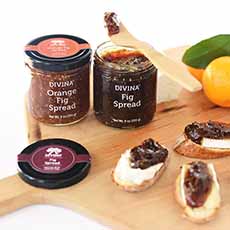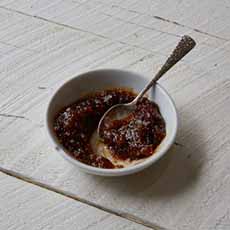Divina Fig Spreads, Uses For Fig Spread & The History Of Figs
|
If you’ve never had a deliciously ripe fig (photo #6), you’re missing out. A superfood rich in fiber, iron, manganese, potassium, and plant calcium*, figs can be enjoyed in many ways (and have medical uses as well). Figs have been a mainstay in the Mediterranean since ancient times. They were a significant part of the basic diet of the ancient Greeks. Greece remains one of the largest producers of figs worldwide. Our Top Pick Of The Week showcases Greek figs as a spread; specifically, the Divina fig spreads (photo #1). And what fig spreads they are! We have long purchased fig spreads, but none as good as these. First: What is a spread? Jam, jelly, marmalade, preserves, and the other types of spreadable condiments, both sweet and savory, can all be called “spreads.” However, in the U.S. manufacturers have co-opted the term “fruit spread” to mean sugar-free/reduced calorie spreads. Blame the FDA for the confusion: In 1940, the Food and Drug Administration created “Standards of Identity” describing what constitutes a jam, jelly, preserve, spread, etc. Here are the different definitions of jam, jelly, preserves, etc. Ignore the U.S. definition for “spread” as you contemplate Divina fig spreads. Divina fig spreads are deeply fruity and complex with notes of caramel and honey. They taste like ripe figs were mashed inside the jar. They’re as close to eating a piece of fruit as we’ve ever experienced in a spread. Even if there were only the “original” fig spread, these delectable condiments have so many uses beyond toast (see them below). Beyond the original, Divina fig spreads are accented with other sweet and savory flavors. Choose among: All the spreads use non-GMO Greek Aegean figs and are all-natural and gluten-free. A bit of an extra commercial for Divina: Everything we have tasted from this brand has been top drawer. You’ll never be disappointed with Divina. Here’s a roundup of how we use fig spread: Produced by FoodMatch, a company whose main business is as producer and importer of Mediterranean specialty foods for the wholesale market, the spreads are available at fine retailers plus: The common fig (Ficus carica) is one of the first plants cultivated by mankind, in the Fertile Crescent. Fossils dating to about 9400 B.C.E. have been found in an early Neolithic village near Jericho, in the West Bank. Based on this find, fig cultivation precedes the domestication of barley, legumes and wheat, and may thus be the first known instance of agriculture! In the millennia before Europe and the Middle East had access to cane sugar or beet sugar, figs were used, in addition to honey, as sweet snacks and in cakes, puddings and other desserts. Figs were brought from Asia Minor to Greece and Rome, then throughout the Mediterranean, and east to India. Figs, which can produce two crops a year, became common food. In 160 B.C.E., Cato the Elder wrote of several different varieties that were grown in his area. A fun fact for foie gras lovers: The Romans used figs to fatten geese for an early version of foie gras. From the 15th century onwards, figs were growing in Northern Europe. |
|
|
|
The word fig, first found recorded in English in the 13th century, derives from the Old French figue, from the Occitan (Provençal) figa, from the Classical Latin ficus (fig or fig-tree). Figs In The New World Figs first came to America in 1520 with Franciscan missionaries, who brought a variety of fig from southern Spain to southern California. Since they were grown on the property of missions, the variety became known as the Mission fig. In the 1850s, settlers brought other varieties from the East Coast and Europe to California, which became America’s primary fig-growing region [source]. There are thousands of fig varieties in the world but today, California specializes in six fresh and two dried types: Golden and Mission dried figs, and Brown Turkey, Kadota, Mission, Sierra and Tiger fresh figs (photo #6). Learn more about them and find many recipes from the California Fig Commission. ________________ *There are numerous plant-based sources of calcium, including almonds, baked beans, black beans, blackstrap molasses, broccoli, collards, kale, oranges, seeds, spinach, tahini, tempeh and tofu [source].
|
||





